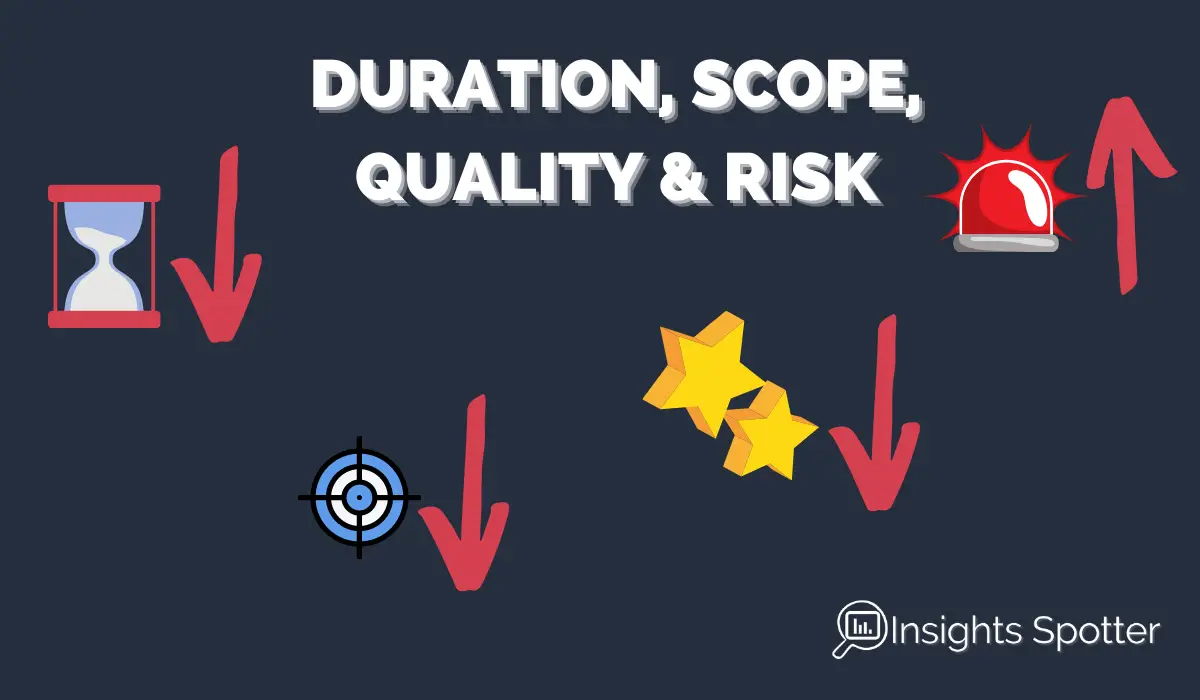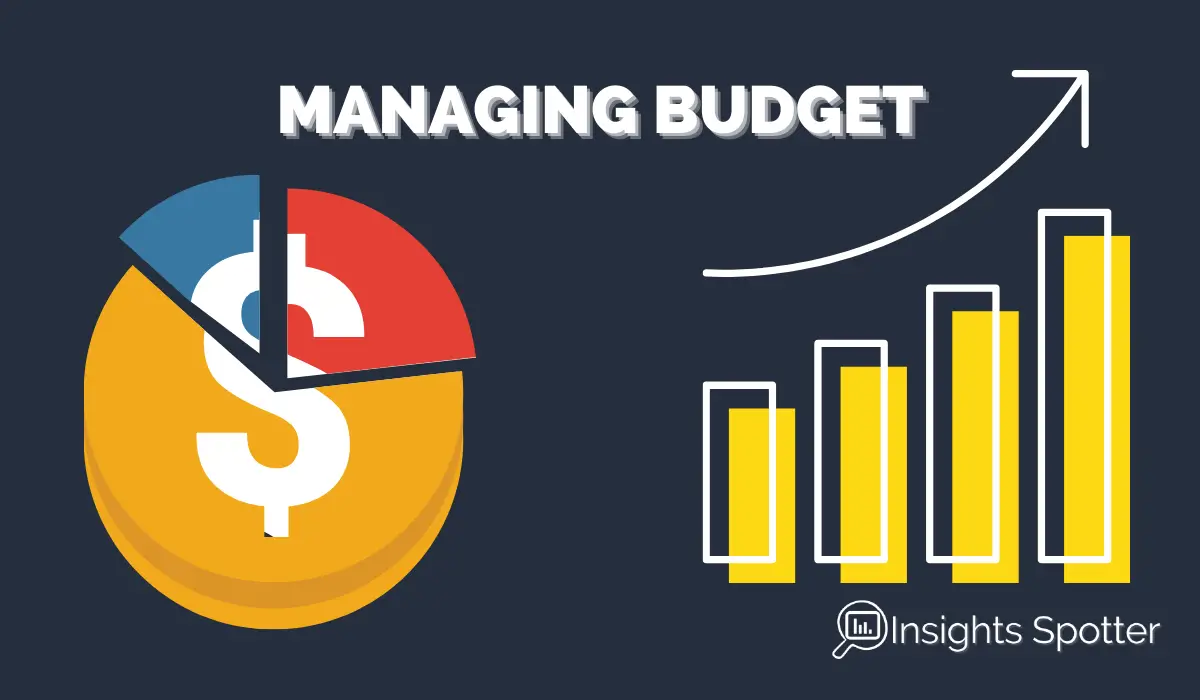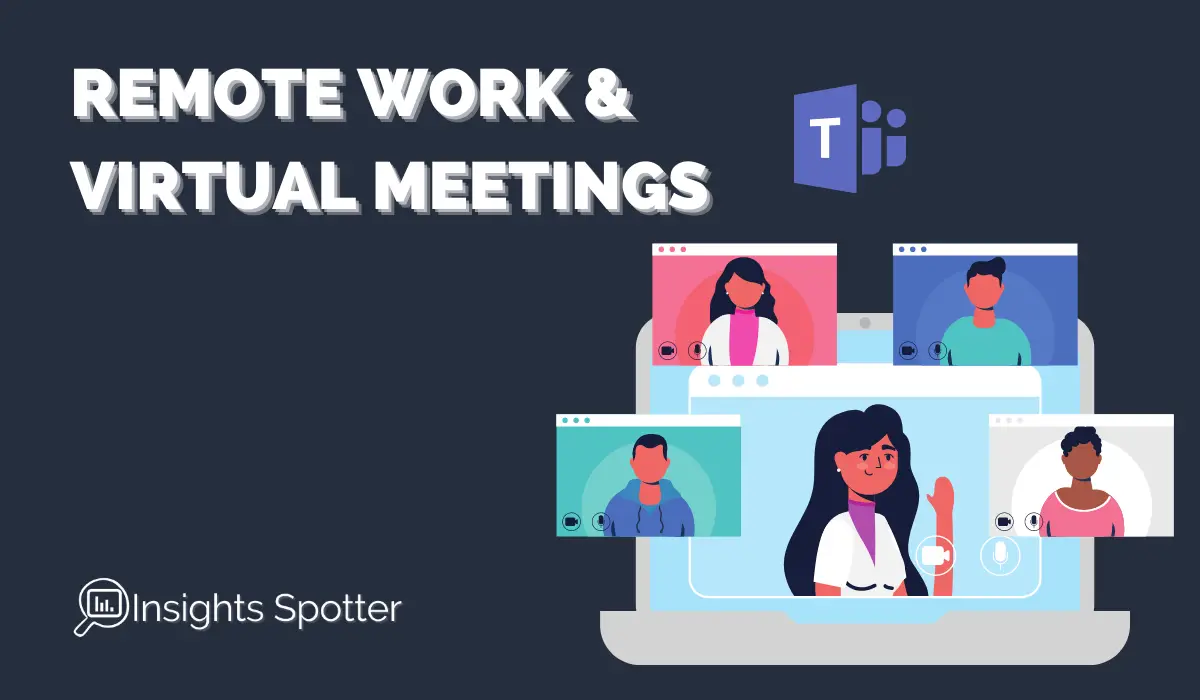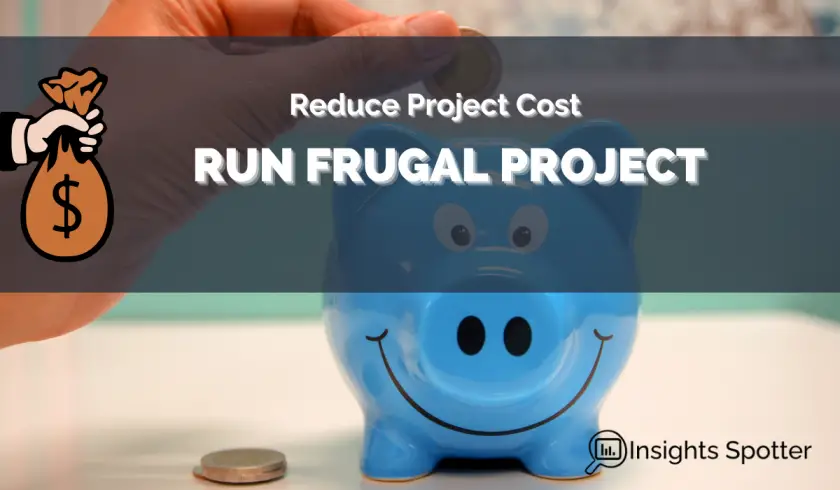Reduce Project Cost: Run Frugal Project
There are so many projects in an ever-changing world where costs go way over budget for medium to larger organisations and projects. For some of these external factors are at play, but often when we have more money, we are not as frugal. But, there are some practical ways you can actually reduce costs by applying even common-sense strategies, and we start by thinking about them in the post.
Keep on reading if you really want to learn how to run your frugal project. It is a bit more challenging than just not thinking and throwing money. Often, these are not even yours but owned by an organisation; thus, you might be less careful. However, if you are anything like me, you will find pride in achieving so much with so little. Hopefully, your managers and senior stakeholders will also recognise what you could do. If they don’t, you can always use budget management strategies and reporting to highlight these achievements.
Still, if I have not convinced you with pride argument, consider that most projects at some point will have challenges with the budget regardless of how well you plan. Therefore, you will look like an ace project manager if you can reduce these costs even before you hit a wall.
If you would like to learn more about budget and cost management, check out my previous post: WHAT HAPPENS WHEN A PROJECT GOES OVER BUDGET? PREVENT IT.
1. Get Expensive but Competent and Experienced Resources
But wait, Paulius, you said that we are going to reduce costs and not increase them! The first approach is a bit more controversial, I agree. You see, if you have to redo the project or parts of it, then it will definitely cost you more.
I am not suggesting you need these expensive but experience resources through the whole project, but you might want to consider them in the planning, initiation phases. To have a successful project, you need to set good frameworks and plans. Experience individuals will ensure that accurate plans are produced and budgets estimated.
These resources will often come in the form of consultants, which could be 3 times more expensive, but they are relatively easy to hire or fire and would have a lot of experience from all other completed projects. Thus, you can start your initiative on the right foot.

2. Do not Forget To Look for Cheaper Human Resources
Now that you have established a good base for your project, you can take a step back and look around for resources that would pick where consultants left off.
These individuals could be internal staff with experience in the projects. For example, these could be subject matter experts (SMEs) for a given area where the project exists.
Also, you could look around externally for smart, inexperienced people who are willing to learn, like recent grads or interns. Some of these individuals can pick things quicker than you at the same age.
Suppose you do not have enough resources internally with project management experience. In that case, you might want to keep one or two consultants with project experience on the payslip to track project execution vs the plan.
Strategic allocation of a budget to retain experience resources that could bring together less experienced staff could also reduce cost but not impact project success considerably.
There could be a possibility to outsource some of the activities. In particular, if these can be done to the same quality but cheaper and are not critical. You might want to avoid critical tasks as you might not have as much control over deliverables.
The conclusion here is that with resources, you need to take a balanced approach. In the end, you will need to have people who have project management experience to steer the project. But you might not need to have the whole team experts in project management to deliver or even have them on the payslip with outsourcing.

3. Be Smart with Your Equipment
Buy used equipment or Rent
We spoke about human resources, but you also have equipment and tools. If you have to dig a hole in the ground, the easy thing would be to go to the shop and buy a shovel.
However, what are you going to do with it when your project digging a hole is finished. The point is that you can actually rent your tools and equipment or, if not possible, buy a used one. When the project is finished, you can sell it. Therefore, you will lock in less cash, which you can use on other project tasks.
Do Not Forget to Utilise the Cloud
The particular type of renting is server power. Several large providers like Azure or AWS, to name a few, provide server renting services. Often organisations are looking to install new online systems and need some computational power. However, you no longer need to buy servers on-premises (on-prem). You can rent those servers from these providers. It will likely be cheaper and more scalable than maintaining your own in the business; maintaining means that you will need to pay for electricity, engineers, space, etc. Also, your project cost will be lower as renting servers will be more affordable than buying them.
Remember that you will likely need computers and tools to complete a project, but you might not need to own them.

4. Reduce Project Duration, Scope, Quality or Increase Risks
Time is money, and project managers know it. You need to pay for various resources, staff, computers, etc., throughout the project. If you manage to reduce the amount of time your project takes, you might cut costs by releasing these resources early.
I have written the whole article about How to speed up a project HOW TO SPEED UP YOUR PROJECT? PRACTICAL ADVICE.
I will not lie; it is pretty hard to reduce the amount of time your project takes. Except if you are lucky, the rest will be down to project constraints scope, quality, resources or Risk, which we have discussed in the previous article. Effectively, you will need to sacrifice one of these or a few of them to cut time and, at the same time, cut costs.
One way to reduce scope is to consider your non-functional requirements or your nice to haves.
When reviewing what you need to do for the project, check if stakeholders could live without some scope items or would be willing to reduce quality. Do not be afraid to negotiate with them, explain the situation with available funding, and they might even offer ways to reduce scope themselves.
For example, could you get a server with 4 cores rather than 16 for a new application and invest the difference in more people, who then can reduce the project’s overall timelines.
Suppose you do not reduce time, scope, quality or get additional resources and try to reduce costs. In that case, you will ultimately increase the risk for project failure, i.e. not meeting set out business or sponsors expectations. In some cases, it could be the situation, but you need to ensure stakeholders accept additional risks.

5. Review Workload & Project Estimates
At the beginning of the project, you have limited information about the exact time to complete some tasks in the middle of the project. Therefore, you make some assumptions and complete your estimates.
However, when the project progresses, you might want to review your workload estimates. Potentially, you were too aggressive with the amount of time you needed. If so, you have an additional capacity now. The additional capacity could be used to complete some other tasks in the project and reduce duration and costs.

6. Managing Project Budget
In order to cut cost, you need to know where you are spending money. Hence, you need to manage your budget. I discuss a few management techniques in my previous posts:
- WHAT TO DO WHEN A PROJECT IS OVER BUDGET? FIX IT
- WHAT HAPPENS WHEN A PROJECT GOES OVER BUDGET? PREVENT IT
Managing a budget is easier than you think. You do not need to finish some PhD in Finance. Start by recording all your external & internal resources, both staff and equipment (including license costs). Consider your project timelines and think about when you will need them and for how long. Multiply the cost of the resources by the duration. Now add everything up. The result is your project’s required budget. You just need to track it over time by reviewing work completed and considering if you have enough to complete the rest. If you would like more sophisticated techniques, check out my links.
One other way to manage your budget is by using Agile principles. Agile frameworks are seeking to have incremental improvements. Before each improvement, you consider essential items. If you run out of important items, you stop your project. This way, you can use your budget for those activities that benefit the organisation or customer the most at any given time.

7. Use Project Management Software
Although there is a cost associated with Project Management Software, these are much cheaper than before. They could save you a lot of time and effort and make it easier to manage your resources and save on costs.
It is your decision what software to select. I had a project where I used excel and integrated templates, like the Gantt chart. For a smaller project, these are just enough. But when you get beyond 2 or so reporting individuals, I would suggest getting something more serious. It will be just more manageable, and you will see much better available capacity.
But do not jump buying a new software from the market yet. Maybe you have software in the organisation already available, like MS Teams, which do not require additional funding and would be virtually free for your project. It has several cool features available like Planner. Also, you can consider using Excel in combination with MS Teams as it allows you to collaborate on work using Microsoft files as a base for planning.
Still, if you could not find an alternative solution in your organisation, it might be time to look into the best solution in the market. Often you will need to select a solution based on the management approach you have. Some will be better with Agile type of collaborations and others more Waterfall. Do your research, but for me promising are the following:
- Monday.com: Best free plan with work templates
- Wrike: Best for scaling organisations. Also, they have an excellent project management blog.
- TeamGantt: Great for visual planning
- JIRA or Confluence: Both widely used in organisations
- Asana: a focus on collaboration
One key point to make on tools is always to keep a perspective. If you do not have a reason for a tool except that it is fancy, do not use it.

8. Work Remotely and Incorporate Virtual Meetings
While I am writing this post, we are still in COVID times, and now more than ever, people are getting used to working from home or just remotely. Almost all of my meetings on projects are virtual as well. Now, that is a good thing if you like to cut your project costs. As we have already established resources, cost money and office space are one of them. If you can run your projects without needing that space, the business can use it for other activities or not pay for it.
The other great thing about virtual meetings is that switching from one meeting to another takes almost no time. Before, COVID you would need to jump from one floor to the other, spending 5-10 min just to start a meeting. Please don’t allow me to begin talking about booking meeting space, which would be an additional 10 min. Plus, If you work in some construction industry, your meeting might be on the other side of the town. With the virtual meetings, you can save time, cut fuel costs and use it for something useful for the project. Say try to make things move faster.

9. Simple Alternative Solution
I really like the stories about space and history about the USA vs SSRS race during the cold war. One story, although somewhat fictional, really illustrates that sometimes simple solutions are just better and cheaper.
The fact is that ink does not go down to the pen’s tip in space due to a lack of gravity. The story goes that the USA spend millions of dollars to design a pen that can write in space. While counterparts in SSRS just used pencils.
The story is not really true, but you can remember it as an example. If somebody gives you a task/requirement, be careful not to be influenced by often suggested solutions. There might be some cheaper alternatives to explore that give a similar result.

10. Gather Requirements in Workshops
As we have explored before, time is money. One particularly consuming preparation part of the project is requirements gathering. There are multiple steps and clarifications, and alignments you need to do in this phase. Usually, you have multiple individuals involved, and often you need their input in several meetings to gather all business needs.
Therefore, you might want to consider organising workshops, which can take anywhere from half a day to two days and more. The idea is that you gather all stakeholders in one place and document the hell out of what they suggest as requirements. You will likely save time and speed up the process by getting all these needs at a single point in time.
However, there is one negative point about such workshops without considering the challenges of getting everyone in the same room. After gathering requirements, the next step is to analyse them, which could bring new revelations requiring amendments and follow up meetings. Workshops are not incremental work, and if you cannot nail down requirements in such a setting, you might just be better with shorter sessions. One way to do this is to have multiple 1 to 2-hour sessions with specific stakeholder groups.

11. Stop Multitasking
Multitasking is one of the most prominent fallacies in the professional world. There is countless evidence that shows multitasking is simply not productive. There is a cost associated with moving from one task to another. Also, the quality could suffer. Try finishing the task you started or at least those that are the most important. You will free up space in your head for the following item.
You can make sure that not just you but your team also limits parallel tasks. What I found is that Kanban boards are a good way to go about it. Kanban methodology has integrated solutions not to multitask excessively, limiting started tasks in each work column or process.
If you like to learn more about this method, check out the post: WHAT IS SCRUMBAN? A GREAT FRAMEWORK

12. Always Ask for a Discount
Often, you will need to acquire some new vendor and onboard it to the organisation for the project. If they are new in this organisation, they will want to have a foot in the door. Thus, you have some negotiation power here. Plus, you would often ask several vendors to participate, which would increase your options. It would be a shame to waste all this negotiation power.
Therefore, always ask for discounts. Vendors usually always have some options available to reduce prices. Do not pay extra just because you do not want to look cheap.

13. Think beyond the cash, Barter
While working in any organisation, you build alliances. If you have an important project, you might want to tap into some of these connections to get some tasks done for free. There could be that a project needs some sample files or needs some consultation, etc.
While these individuals are helping you, you can learn more about their views and help to share some information about the project. Later if these managers need some help, you can return the favour.

14. Bundling Work
Sometimes for more extensive projects/programmes, you will have some joint resources, like a contractor that supports the whole programme with server installations.
If your project is part of that programme, you could transfer some of the project scope’s items to the programme and that contractor to reduce your project expenses. The contractor could even have lower rates as the joint order is larger.
One other alternative is to look for a project around your organisation and understand if there are deliverables that the same vendor can fulfil. You can then go together with the additional project to seek better vendor terms and reduce costs. Or you could simply share costs between two initiatives if requirements are fulfilled for both.

15. Reward your High Performance
Do not forget to say a kind word to those staff members who perform well. In particular to higher management. Increasing staff morale could improve their efficiency and also ensure that their work is respected and noticed. You want to keep your best performing individuals to ensure that the project is going full speed ahead and that you are not wasting unnecessary money.
Running Frugal Project: Conclusion
So we have seen many examples of how you can be more conscious about your project costs. Keeping a close eye on your costs will help you ensure you do not need to go to business and ask for more. Trust me; it is not a pleasant conversation.
I guess the most important lesson here is to be strict with your costs, not just when things get tough but straight from the beginning. Projects mostly never go by the plan, and have some saved up buffer could save you your skin.
Cost management is a continuous process. There are always opportunities to save or share costs between projects. So keep a watchful eye and good luck!
Subscribe to our newsletter!
 ABOUT ME
ABOUT ME
I am an experienced ex. Business & Data Analyst and now a Project Manager with multiple years of experience gained in several international companies.
These days, business problems require data crunching and telling stories to make the right decisions. Simply put, business stakeholders need insights into their projects and deliveries.
This is where I come in. I have learned and applied Python, Power BI, SQL and Excel to analyse and present data. Also, I gained experience in Project Management and Business Analysis. So, I can not only spot insights but execute business decisions. Moreover, I can teach you as well. Read More
Best Books








Latest Blog Posts
- Navigating Project Management in a Matrix Organization: Challenges and Solutions
- Using Artificial Intelligence’s Power in Agile Project Management
- Sustainable Project Management: Trends, Tools, & Strategies
- Unlocking Strategic Value: How NIST CSF 2.0 Shapes Project Choices for Better Outcomes
- Cybersecurity Project Management: Protecting Your Digital Frontier
- What are the Different Types of Planning in Project Management?

Need Project Manager’s Help!?
Check out the Fiverr marketplace if you do not have time to run your own projects or just need extra help. They do have multiple project professionals, including project managers. Maybe you will find just the right fit to take some burden from you. I have used Fiverr in the past. The prices are also not too bad. If you seek PM via the corporate route, it will be easily 5x the price.


